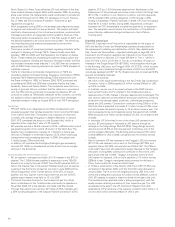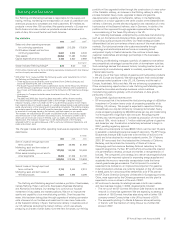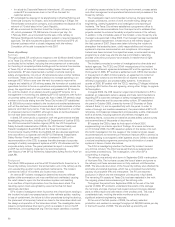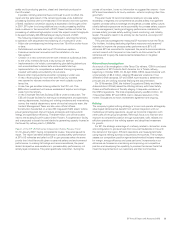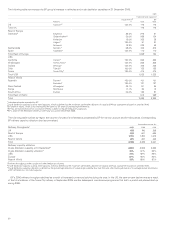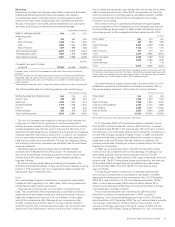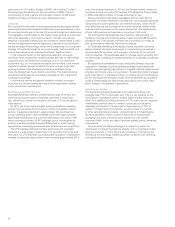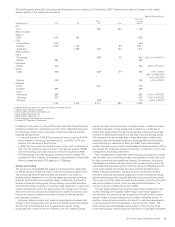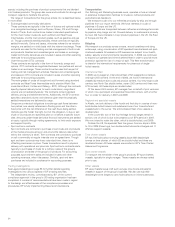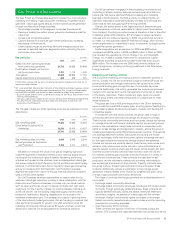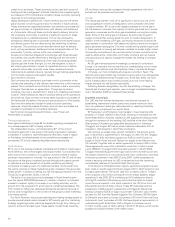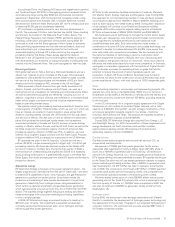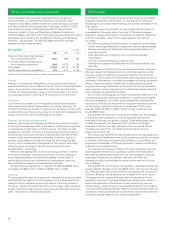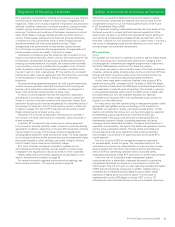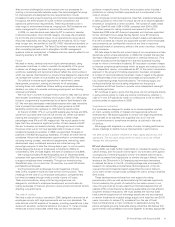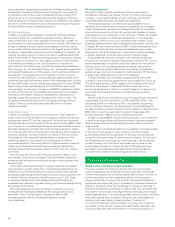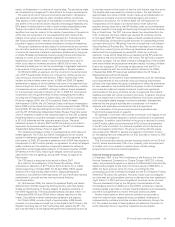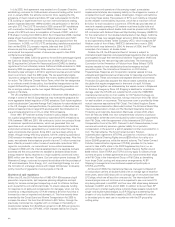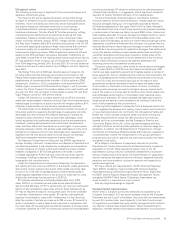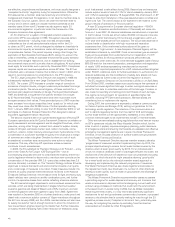BP 2006 Annual Report Download - page 38
Download and view the complete annual report
Please find page 38 of the 2006 BP annual report below. You can navigate through the pages in the report by either clicking on the pages listed below, or by using the keyword search tool below to find specific information within the annual report.traded on an exchange. These contracts can be used both as part of
trading and risk management activities. Realized and unrealized gains
and losses on OTC contracts are included in sales and other operating
revenues for accounting purposes.
Highly developed markets exist in North America and the UK where
gas and power can be bought and sold for delivery in future periods.
These contracts are negotiated between two parties to purchase and
sell gas and power at a specified price, with delivery and settlement
at a future date. Although these contracts specify delivery terms for
the underlying commodity, in practice a significant volume of these
transactions are not settled physically. This can be achieved by
transacting offsetting sale or purchase contracts for the same location
and delivery period that are offset during the scheduling of delivery
or dispatch. The contracts contain standard terms such as delivery
point, pricing mechanism, settlement terms and specification of the
commodity. Typically, volume is the main variable term.
Swaps are contractual obligations to exchange cash flows between
two parties. One usually references a floating price and the other a
fixed price, with the net difference of the cash flows being settled.
Options give the holder the right, but not the obligation, to buy or
sell natural gas products or power at a specified price on or before
a specific future date. Amounts under these derivative financial
instruments are settled at expiry, typically through netting agreements,
to limit credit exposure and support liquidity.
– Spot and term contracts
Spot contracts are contracts to purchase or sell a commodity at the
market price prevailing on the delivery date when title to the inventory
passes. Term contracts are contracts to purchase or sell a commodity
at regular intervals over an agreed term. Though spot and term
contracts may have a standard form, there is no offsetting mechanism
in place. These transactions result in physical delivery with operational
and price risk. Spot and term contracts relate typically to purchases of
third-party gas and sales of the group’s gas production to third parties.
Spot and term sales are included in sales and other operating
revenues, when title passes. Similarly, spot and term purchases are
included in purchases for accounting purposes.
See Financial and operating performance – Gas, Power and
Renewables on page 53.
Trading investigations
See Legal proceedings on page 85 for details regarding investigations
into various aspects of BP’s trading activities.
The independent review, commissioned by BP, of the current
compliance approach in the group’s US trading organization has been
completed. A number of recommendations have been made in regard
to the design and effectiveness of the compliance processes and
procedures. BP is fully implementing these recommendations.
North America
BP is one of the leading wholesale marketers and traders of natural gas in
North America, the world’s largest natural gas market. Our business has
been built on the foundation of our position as the continent’s leading
producer of gas based on volumes. Our gas activity in the US and Canada
has grown as the group increased its scale through both organic growth
of operations and the acquisition of smaller marketing and trading
companies, increasing reach into additional markets. At the same time,
the overall volumes in these markets have also increased. The group also
trades power, in addition to selling and risk managing production from the
Texas City co-generation facility in the US.
The scale of our gas and power businesses in North America grew
over the period 2004-2006 because of a number of factors: (i) increased
access to transport rights; (ii) increase in our trading activities; and (iii)
growth from the acquisition of small regional marketing businesses. The
OTC market for NGLs also developed during this period but the scale of
activity was not significant in the context of the group’s overall marketing
and trading activity.
Our North American natural gas marketing and trading strategy seeks to
provide unconstrained market access for BP’s equity gas. Our marketing
strategy targets high-value customer segments through fully utilizing our
rights to store and transport gas. These assets include those owned by
BP and those contractually accessed through agreements with third
parties such as pipelines and terminals.
Europe
The natural gas market in the UK is significant in size and is one of the
most progressive in terms of deregulation when compared with other
European markets. BP is one of the largest producers of natural gas in
the UK based on volumes. The majority of natural gas sales are to power-
generation companies and to other gas wholesalers via long-term supply
deals. Some of the natural gas continues to be sold under long-term
supply contracts that were entered into prior to market deregulation. In
addition to the marketing of BP gas, commodity derivative contracts are
used actively in combination with assets and rights to store and transport
gas to generate trading gains. This may include storing physical gas to sell
in future periods or moving gas between markets to access higher prices.
Commodity contracts such as over-the-counter forward contracts can be
used to achieve this, while other commodity contracts such as futures
and options can be used to manage the market risk relating to changes
in prices.
As UK gas markets become increasingly connected to continental
Europe, it is important that we maintain our understanding of how wider
European gas markets work. We therefore trade in continental Europe.
In Europe, our main marketing activities are currently in Spain. The
Spanish natural gas market has continued to grow and is now deregulated
ahead of the deadlines set by European law. Since April 2000, we have
built a market position that currently places us as one of the leading
foreign entrants into the Spanish gas market.
Following Spanish deregulation, our 5% shareholding in Enagas, the
Spanish gas transport grid operator, was no longer considered strategic
and in November 2006 we divested these shares.
Liquefied natural gas
Our LNG and new market development activities are focused on
establishing international market positions to create maximum value
from our upstream natural gas resources and on capturing third-party
LNG supply to complement our equity flows.
BP Exploration and Production has interests in major existing LNG
projects in Trinidad, ADGAS in Abu Dhabi, Bontang in Indonesia and the
North West Shelf in Australia. Additional LNG supplies are being pursued
through an expansion of the existing LNG facilities at the North West
Shelf project in Australia and greenfield developments in Indonesia
(Tangguh) and Angola. BP has no proved reserves associated with its
interests in LNG projects in Abu Dhabi and Angola.
We continue to access major growth markets for the group’s equity
gas. In Asia Pacific, agreements for the supply of LNG from the Tangguh
project (BP 37.2%) have been signed with POSCO and K-Power for
supply to South Korea and with Sempra for supply to the Mexican and
US markets. Together with an earlier agreement to supply LNG to China,
these agreements mean that markets for more than 7 million tonnes
a year (380bcf) of Tangguh LNG have been secured. In March 2005,
Tangguh received key government approvals for the two-train launch and
the project consortium is now executing the major construction contracts,
with start-up planned in late 2008. During 2006, further progress was
made in securing contracts for LNG to be derived from the remaining
uncontracted reserves at the North West Shelf project.
In the Atlantic and Mediterranean regions, significant progress has also
been made in creating opportunities to supply LNG to North American and
European gas markets. The fourth LNG train at Atlantic LNG in Trinidad,
with a capacity of 5.2 million tonnes per annum (mtpa) (253bcf), began
operations in late 2005. BP is marketing its LNG entitlement directly,
utilizing BP-controlled LNG shipping and contractual rights to access
import terminal capacity in the liquid markets of the US (Cove Point and
Elba Island) and the UK (Isle of Grain). These BP-marketed volumes
supplement a 2005 long-term agreement with Egyptian Natural Gas
Holding Company (EGAS) of Egypt to purchase 1.45 billion cubic metres
per year of LNG from the Spanish Egyptian Gas Company (SEGAS) plant
at Damietta, short-term contracts to purchase LNG from Oman and Qatar
and periodic ‘spot’ purchases of LNG. We have signed a memorandum of
understanding with Brass River LNG in Nigeria to purchase around
2 million tonnes a year of LNG, starting in 2010 for 20 years, which will be
supplied to multiple markets in the Atlantic basin.
36


